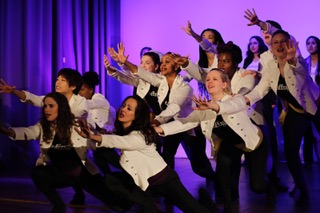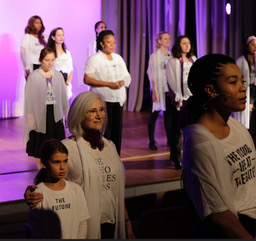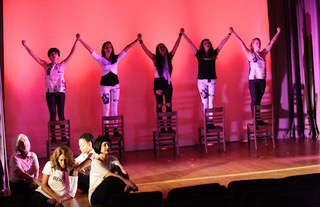For Jennifer Schwed, Election Day 2016 brought the full gamut of emotions.
Like many women across the country, she woke up the morning of November 8, 2016 in a state of expectant elation—fueled by the belief that our nation was on the cusp of electing its first female president. Instead, when she went to bed that night, Donald Trump, a self-avowed sexual predator who routinely denigrates women, was slated to move into the White House.
As she shook off the shock and disbelief, Schwed decided that an America that could elect Donald Trump as president, was an America that didn’t care about women. She decided to table her long-simmering idea of producing a musical about how women fought—and won—the right to vote.
And then the Women’s March happened. Standing between the Capitol and the Washington Monument—part of an infinite mass of well-bundled men, women and children wearing pink hats and carrying signs with messages like “A Woman’s Place is in the Revolution” or “This Pussy Grabs Back”—Schwed changed her mind.
“I realized that these are exactly the stories that need to be heard,” she said.
She proposed the idea to her business partner Doug Bradshaw—and he pegged it “19.”
More than three years later, 19: The Musical is a two-hour musical that chronicles women’s struggle to gain the right to vote—which was finally won a century ago with the 19th amendment to the U.S. constitution. Modeled after Hamilton, 19 brings to life a story that few Americans know or understand.

The main character is based on Alice Paul, one of the key leaders of the women’s suffrage movement.
“I couldn’t believe that I didn’t really know who Alice Paul was. Turns out, very few people seem to know who she was,” said Bradshaw.
19 also incorporates the perspectives of Ida B. Wells, Susan B. Anthony, Carrie Chapman Catt, Inez Milholland and others. However, with existing historic material on suffrage in America that is both sprawling and contradictory—Paul herself, unlike Alexander Hamilton, kept very few personal records—Schwed and Bradshaw decided that it would be extremely difficult, if not impossible, to portray a strictly factual account of the movement. They opted instead to occasionally use composite characters or scenes to depict certain relationships and major themes, to move the action along or to give the audience the big picture.
“There are so many conflicting stories, one contingent will say, ‘No it happened this way,’ the other will say, ‘No, it happened this way,’” Schwed said. “There is no one bible of history on suffrage and how these things went down.”
Schwed and Bradshaw—who together founded Through the Fourth Wall, an award-winning theater, film and interactive digital media company—have collaborated on many productions over the years. 19 is their most ambitious to date—and their first musical.

They knew they needed a composer: a third partner who would play a crucial role by writing and producing the music to match their lyrics. They set out in search of a female composer who was well-versed in 1920s jazz. Schwed posted a message to a listserv for women in film and video. Her first response came from composer Charlie Barnett, who happened to be a man.
“I think I’m your guy,” he told Schwed. He later admitted laughingly to not being “a close reader of ads.”
“He’s a brilliant musician,” Schwed said. “And while I originally wanted more women involved with 19, there’s something to be said for men to be excited and interested in elevating it too.”
The threesome got to work writing the script and the songs.

“It’s a genre stew,” Barnett noted. “We’ve created 50-60 songs; we’re on version 15 of the script. Some really good songs ended up on the cutting room floor. As the script evolved, so did the songs. As much as I am a completionist at heart, I had to accept the malleability of this thing, always in flux, always ready to be redone, rewritten, rethought over.”
They then recruited the cast: 19 women and two men, many of whom have stayed with the production from the beginning. Karen Bralove is the oldest cast member at 74.
“If you commit to two years of unpaid rehearsals and a constantly changing script, you’re obsessed,” Bralove said. “I was obsessed with the story of these women. In 1920, my grandmother was alive and she got to vote; my mom was seven years old. I touch history.”
Beginning in late 2017, they began workshopping 19 with more than 30 performances around the Washington, D.C. area. With Barnett on the piano, Schwed and Bradshaw attended each performance. Together, they all held question-and-answer sessions afterwards to elicit audience feedback.
One of the hardest parts to portray was the chief internal conflict that roiled the movement—incorporating women of color. They ended up creating a heated discussion between Paul and Ida B. Wells, an African-American journalist, abolitionist and feminist, about whether or not they would integrate a 1913 march for the vote in Washington. The discussion became the show’s most popular song, “Put Yourself in My Shoes.”
“We knew there was massive racism in the movement,” said Bradshaw. “But as far as we know, Ida never walked into Alice’s office and spoke to her, we completely made that up.”

In the show, Paul argued against integrating the march because Southern white women threatened to boycott if African-American women were allowed to march alongside them. They wanted women of color segregated and walking in the rear. Wells argued for integration because the women’s suffrage movement was about gaining the right to vote for all women. And, as she noted, African-American women were fighting for more than the vote: They were fighting for their lives.
The song begins in Paul’s voice:
“Put yourself in my shoes; we have no time to lose. Only one more shot to change this plot and win the prize for which we’ve fought so hard. Put yourself if my shoes.”
Wells then takes over:
“Don’t talk to me ‘bout your pain. You’ve never seen loved ones slain. I won’t be denied, ignored or pushed aside.”
The song ends with the two of them singing together:
“Put yourself in my shoes. We have no time to lose.”
For Schwed, talking about racism was always an important part of telling the movement’s story.
“This was never meant to be strictly a celebration of the movement,” she said. “When women are talked about they are either perfect or evil. I wanted to walk in the middle of that and say they were human, they were fallible, they made mistakes.”
The show also portrays the beatings, forced feedings, arrests and imprisonment that the women of the suffrage movement endured.
“It’s very emotional,” Bralove noted.
The first full performances of 19 were held at the National Museum of Women in the Arts in November 2019, in front of sold-out audiences. Now, the production goes to New York in search of investors, producers and theater companies interested in staging it. Schwed, Bradshaw and Barnett all believe that the show can teach important lessons about history and women’s continued fight for equality.
“2020 is just the coming out party of the show. We think it should go on for a long time,” Bradshaw said.
Barnett would like to see it become a show performed by high schools across the country.
“It’s the perfect message for what every high school in America should be putting on,” he said.
Throughout the three years of writing, producing, revising and performing—all while maintaining day jobs to pay the bills—Schwed has kept a vision in her mind of the women of the suffrage movement under ice. She believes that 19 is allowing that ice to begin to thaw, bringing new life to the suffragists and their stories.
“The good part and bad part about the show is that it’s relevant,” she said. “The struggle continues.”
For more information, visit www.19themusical.com.

